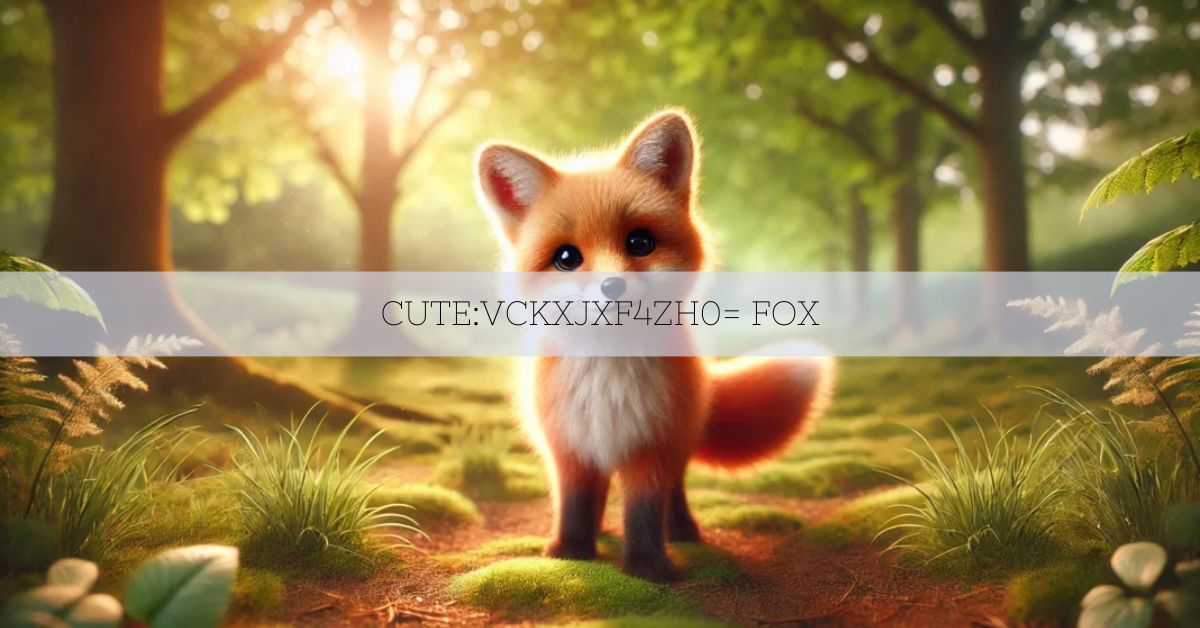Last summer, I went on a camping trip in the mountains with a few friends. One evening, as we were sitting around the campfire, I noticed a movement in the bushes nearby. Curiosity piqued, I quietly crept over and was thrilled to see a cute fox peeking out from behind a tree.7
The cute:vckxjxf4zh0= fox is a delightful symbol of nature’s charm, captivating many with its playful demeanor and striking appearance. Encountering a fox in the wild can inspire a love for wildlife and a commitment to conservation efforts.
Stay tuned with us as we talk about the adorable cute:vckxjxf4zh0= fox ! We’ll share fun facts about its playful behavior and why it’s so special. You won’t want to miss these cute details! Get ready to discover the charm of this little creature!
What Is A cute:Vckxjxf4zh0= Fox ?
A “cute fox” refers to the adorable traits that make foxes so lovable. One reason people find them cute is their playful behavior. Foxes often jump around and play, which can be really fun to watch. They also have fluffy fur and bushy tails, making them look extra cuddly. Their small size adds to their charm, making them seem less intimidating than larger wild animals.
Another reason people think foxes are cute is their expressive faces. With big, bright eyes and unique markings, their faces have a lot of personality. These features make foxes appealing and captivating to many. Overall, the term “cute fox” captures the endearing qualities that make these animals special and beloved by many.
Where Can I Find cute:vckxjxf4zh0= fox In The Wild?
Cute foxes can be found in various habitats around the world, depending on the species. The most common type, the red fox, is widely distributed across North America, Europe, and parts of Asia. You can often spot them in forests, grasslands, and even suburban areas, as they adapt well to different environments. In the wild, foxes are most active during dawn and dusk, so early morning or late evening is the best time to look for them.
If you’re hoping to see cute foxes in their natural habitat, consider visiting national parks or wildlife reserves. Places like Yellowstone National Park in the U.S. or the Scottish Highlands in the UK are known for their fox populations. Remember to observe from a distance and avoid disturbing their natural behavior.
How Does The Cute Fox Adapt To Its Environment?
Cute foxes are remarkable at adapting to their environments, which helps them survive in various habitats. One of the key adaptations is their fur, which changes color with the seasons. For instance, the red fox has a vibrant reddish coat in summer that blends well with the environment, while its fur becomes thicker and fuller in winter, helping it stay warm and camouflaged in snowy landscapes.
Foxes are also skilled scavengers and hunters, which helps them thrive in diverse settings. They can eat a wide variety of foods, including small mammals, birds, fruits, and even garbage in urban areas. This adaptability in diet allows them to find food sources no matter where they live. Moreover, foxes are known for their cleverness and resourcefulness, often using their intelligence to navigate challenges in their environment.
What Are The Most Common Myths About Cute Foxes?
- Wild and Dangerous: Many believe all foxes are wild and dangerous. In reality, most foxes, like the red fox, are shy and avoid humans. They are generally not aggressive unless threatened.
- Cunning and Deceitful: Foxes are often portrayed as cunning and deceitful in folklore. While they are intelligent and capable of clever behavior, this stereotype exaggerates their nature.
- Always Nocturnal: Some think all foxes are nocturnal, but they can be active during the day or night, depending on their environment and food availability.
- Foxes Can’t Be Tamed: Another myth is that foxes are untamable. However, some people do keep domesticated foxes as pets, proving they can be friendly and social.
- All Foxes Are the Same: There’s a misconception that all fox species share the same traits. Different species, like the Arctic fox and the fennec fox, have unique adaptations and behaviors suited to their environments.
How Can I Care For A Cute Fox As A Pet?
Taking care of a cute fox can be a fun and rewarding experience, but it’s important to know what they need. First, make sure to check your local laws, as some places have rules about keeping foxes as pets. Choose a friendly type of fox, like a Fennec fox, which is better suited for life with people.
Create a safe and spacious area for them to play and explore, and provide a balanced diet of good dog food, fruits, and vegetables. Don’t forget to visit a vet who understands foxes to keep them healthy.
Socializing your fox is key, so spend time with them and train them using positive rewards. They need plenty of mental stimulation, so give them toys and engage in playtime to keep them happy. Regular grooming will help keep their fur nice and tidy.
Caring for a fox takes time and commitment, so make sure you’re ready for a long-term relationship with your new furry friend!
What Are The Unique Traits Of A Cute Fox?
- Adorable Appearance: Foxes have large, expressive eyes and pointy ears that contribute to their cute look.
- Bushy Tail: Their thick, bushy tail helps with balance and serves as a means of communication.
- Varied Coat Colors: Foxes come in various colors, including orange, white, and gray, depending on the species.
- Intelligence: They are known for their problem-solving skills and quick thinking.
- Hunting Skills: Foxes are proficient foragers with excellent hunting abilities.
- Social Creatures: They often form close bonds with family members.
- Communication: Foxes use a variety of sounds, such as barks and howls, to communicate with each other.
Can I Spot A Cute Fox In Urban Areas?
Yes, you can spot cute foxes in urban areas! Many foxes have adapted well to city life, often seen wandering through parks, gardens, and even residential neighborhoods. They are mostly active during dawn and dusk, making these times ideal for spotting them. Look for their characteristic bushy tails and pointy ears as they scurry around in search of food.
Urban foxes typically hunt small animals like rabbits or scavenge for leftovers, so they can thrive in these environments. While they may be shy, if you stay quiet and patient, you might catch a glimpse of these charming creatures exploring their urban habitat!
FAQs:
What Do Cute Foxes Eat?
Cute foxes primarily eat small mammals, birds, fruits, and insects. In urban areas, they might also scavenge for leftovers from human food. Their diet varies depending on their habitat and available food sources.
Are Cute Foxes Social Animals?
Cute foxes are generally solitary animals, but they can be social during mating season or when raising kits (young foxes). They often communicate through various vocalizations, body language, and scent marking.
Do Cute Foxes Make Good Pets?
While cute foxes can be charming, they are not recommended as pets. They require a lot of space, a specific diet, and specialized care. Additionally, many areas have legal restrictions on keeping foxes as pets.
How Do Cute Foxes Communicate?
Cute foxes communicate using a variety of sounds, including barks, screams, and growls. They also use body language, like tail positioning and ear movements, to express their feelings and intentions to other foxes.
What Is The Lifespan Of A Cute Fox?
In the wild, cute foxes typically live around 3 to 6 years, but they can live longer in captivity, often reaching up to 10 years or more with proper care. Factors like habitat, food availability, and predation influence their lifespan.
Conclusion:
Cute foxes are fascinating creatures that captivate our hearts with their playful nature and unique traits. Understanding their behavior, habitat, and care requirements can deepen our appreciation for these charming animals.
Whether in the wild or as potential pets, cute foxes remind us of the beauty of nature and the importance of preserving their environments. Stay connected with us for more insights into the enchanting world of cute foxes!
Read more:



